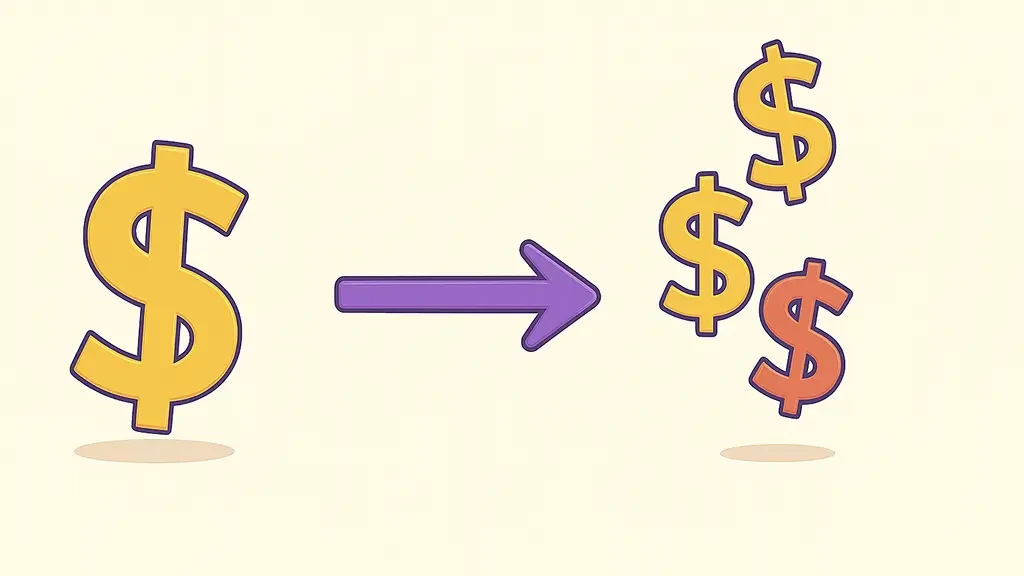How to Determine Earnings Per Share
Learn how to determine earnings per share with our guide. We cover the formulas, examples, and analysis you need to understand this key financial metric.

Earnings Per Share (EPS) tells you exactly how much profit a company makes for each share of its stock. To find it, you take the company’s net income, subtract any dividends paid out to preferred shareholders, and divide that by the average number of common shares floating around. This one number is one of the most direct ways to gauge a company's financial health.
Why Earnings Per Share Matters to You

For anyone digging into financial statements, understanding EPS is non-negotiable. Think of it as each shareholder's slice of the profit pie. It gives investors, analysts, and even business leaders a quick, standardized yardstick for profitability, especially when comparing companies in the same industry.
The idea is simple: a consistently rising EPS signals a company is getting more profitable over time, which is exactly what you want to see. On the flip side, a declining EPS can be a major red flag, pointing to underlying financial troubles.
Key Uses For EPS
The value of EPS goes far beyond a single number on a report. It's a versatile metric used in a few critical ways:
- Assessing Financial Health: It's a snapshot of a company’s ability to generate real profit for its owners.
- Benchmarking Performance: You can put a company's EPS right next to its competitors to see who is operating more efficiently.
- Tracking Trends Over Time: Watching EPS over several quarters or years helps reveal growth patterns, stability, or potential problems on the horizon.
Before we jump into the formula, it helps to know exactly what goes into the calculation. These are the core components you'll need, all of which can be found in a company's financial reports.
Key Inputs for the Basic EPS Calculation
The most common way to determine earnings per share is by dividing a company's net income by its weighted average number of common shares outstanding. For context, the S&P 500's aggregate EPS was 217.05 as of March 1, 2025, showing the combined profitability of the index's companies. You can review current S&P 500 EPS data on GuruFocus.com.
Ultimately, mastering EPS isn't just about plugging numbers into a formula; it's about interpretation. Grasping this key financial indicator is vital for evaluating a company's true profitability. For a fuller picture, it's also smart to explore other key investment metrics that provide a more complete view of an asset's potential. This section lays the essential groundwork, showing why EPS is a cornerstone of any solid financial analysis.
Calculating Basic EPS with a Real-World Example
Alright, let's move from theory to actually crunching some numbers. The best way to get a feel for how to determine earnings per share is to walk through a real-world scenario. While the formula itself looks simple, each part of it tells a crucial piece of the company's financial story.
The formula for basic EPS is: (Net Income - Preferred Dividends) / Weighted Average Common Shares Outstanding
Each of these inputs is vital. Net Income is the company's bottom-line profit—what’s left after every single expense, interest payment, and tax bill is paid. We subtract preferred dividends because that money is promised to preferred shareholders, so it's not available to us common stockholders. To get these figures right, you have to pull them from the company's financial statements. If you're interested in really sharpening your skills, understanding how to approach preparing financial statements from scratch is a huge advantage.
Applying the Formula to Innovate Corp
Let’s put this into practice. Imagine a fictional company, Innovate Corp., just closed its books for the fiscal year. Here are its numbers:
- Net Income: $25,000,000
- Preferred Dividends Paid: $2,000,000
- Weighted Average Common Shares Outstanding: 10,000,000
First, we need to figure out the slice of the profit pie that belongs to common shareholders.
$25,000,000 (Net Income) - $2,000,000 (Preferred Dividends) = $23,000,000
With that number, we can now calculate the EPS. We just divide the available earnings by the weighted average number of shares.
$23,000,000 / 10,000,000 Shares = $2.30 per share
The Basic EPS for Innovate Corp. comes out to $2.30. This means for every share of common stock, the company earned $2.30 in profit this year. This is the bedrock figure you'll use for deeper analysis.
It's absolutely critical to use the weighted average number of shares. Why? Because companies issue new shares and buy back old ones all the time, which changes the total share count throughout the year. A company's stock split history also has a major effect on the number of shares outstanding, and checking it gives you essential context. This simple walkthrough demystifies the whole process, giving you the confidence to calculate EPS for any company you're looking at.
Understanding Diluted EPS for a Fuller Picture

While Basic EPS gives you a solid starting point, it doesn't tell the whole story. To get a more cautious—and frankly, more complete—view of a company's profitability, you need to look at diluted earnings per share. This metric answers a critical "what-if" question that every savvy investor should be asking.
What if all the potential shares out there suddenly became real? Many companies, especially in tech and growth sectors, issue securities that can be converted into common stock down the road. We call these dilutive securities.
Common Types of Dilutive Securities
Think of these as shares-in-waiting. When they come into play, the ownership pie gets split into more slices.
- Stock Options: A classic perk for employees, giving them the right to buy company stock at a set price.
- Warrants: Similar to options but often issued to investors and typically have longer terms.
- Convertible Bonds: These are debt instruments that holders can swap for a predetermined number of common shares.
When these securities are converted, the total number of shares outstanding goes up, which "dilutes" the earnings available to each existing shareholder. Diluted EPS shows you what earnings per share would look like in this more crowded scenario.
For example, tracking a company's earnings quarter-over-quarter gives you a real feel for its momentum. S&P Global (ticker SPGI) reported an EPS of $3.77 in Q4 2024, which grew to $4.43 by Q2 2025. That's a jump of about 17.5% in just two quarters. Analysts pore over these figures, and they almost always focus on the diluted number to gauge the company's underlying financial strength.
By accounting for all potential shares, Diluted EPS provides a worst-case-scenario calculation. This is why analysts often favor it, especially when analyzing companies with complex capital structures or those who lean heavily on stock-based compensation.
Let's go back to our 'Innovate Corp.' example. We already know its basic EPS is $2.30. But now, let's say it also has convertible bonds that, if exercised, would add another 2,000,000 shares to its float.
- Adjusted Shares Outstanding: 10,000,000 (original) + 2,000,000 (potential) = 12,000,000
- Diluted EPS Calculation: $23,000,000 / 12,000,000 shares = $1.92 per share
That's a big difference. The Diluted EPS of $1.92 is significantly lower than the Basic EPS of $2.30, painting a more conservative—and often more realistic—picture of Innovate Corp.'s true profitability. Understanding events that can alter share counts is crucial; checking a company's stock split history can also provide important context for these changes.
How to Interpret EPS and What It Really Means

Calculating a number is one thing; knowing its story is another. Once you’ve pinned down a company's earnings per share, the real work begins. I get this question all the time: "What's a good EPS?" The truth is, there's no magic number. An EPS of $5.00 might be phenomenal for a high-growth software startup but completely underwhelming for a mature utility company.
The true value of EPS comes from context. A standalone number tells you almost nothing. To get the full picture, you have to look at it from a few different angles to pull out meaningful insights about a company's health and valuation.
The most powerful way to use EPS is to track it over time. A single quarter's result could be a fluke, but a clear trend over several years reveals the real story of growth, stagnation, or decline.
Creating Context for Your Analysis
To really understand what an EPS figure is telling you, you need to compare it against relevant benchmarks. This is how a simple data point becomes actionable intelligence.
Here are the most effective ways I've found to add that crucial context:
- Historical Performance: Is the company's current EPS higher or lower than its own results from previous quarters and years? Seeing consistent, quarter-over-quarter growth is one of the strongest positive signals you can find.
- Industry Peers: How does the company's EPS stack up against its direct competitors? This comparison quickly shows whether it's a leader or a laggard within its specific sector.
- Analyst Expectations: Wall Street analysts publish EPS estimates before earnings are announced. Beating these expectations can send a stock soaring, while even a small miss can have the opposite effect.
Connecting EPS to Stock Valuation
Finally, EPS is the bedrock of one of the most popular valuation metrics out there: the Price-to-Earnings (P/E) ratio. This ratio is found by dividing a company's stock price by its earnings per share, and it tells you how much investors are willing to pay for each dollar of a company's earnings.
The P/E ratio is a vital tool for putting EPS into a broader market context. Historically, S&P 500 companies have shown that typical P/E ratios often fall somewhere between 10 and 20. You can learn more about historical P/E ratio valuations and their market implications.
By comparing a company's P/E ratio to its peers and its own historical averages, you can get a much better sense of whether its stock is fairly valued, overvalued, or potentially a bargain.
Let Software Do the Heavy Lifting
Manually calculating basic and diluted EPS for a handful of companies is tedious enough. You have to dig through quarterly reports and financial statements just to find the right inputs. Frankly, it’s a time-consuming chore that pulls you away from actual analysis.
This is where modern financial platforms completely change the game. Instead of hunting for net income and share counts, a tool like PinkLion pulls this data for you instantly. Forget the error-prone number-crunching; these platforms do the heavy lifting, freeing you up to focus on what the numbers actually mean. Your research suddenly shifts from a data entry task to an efficient, insightful process.
The real advantage, though, comes from visualization. PinkLion plots EPS trends over multiple quarters or years with clean, intuitive charts. This helps you spot growth patterns, seasonality, or potential red flags at a glance.
Visualizing Trends and Comparisons
Here’s a perfect example of how PinkLion displays historical EPS data right alongside analyst estimates, giving you immediate context.
The chart clearly shows the company's reported EPS versus what analysts expected. This visual format makes it incredibly easy to see whether a company is consistently beating or missing its targets over time.
Beyond a single stock, you can set up alerts for earnings announcements or even compare multiple companies side-by-side on the same screen. This is incredibly powerful for benchmarking a company against its direct competitors without needing to build your own complex spreadsheet from scratch.
By automating data collection and providing clear visualizations, you can analyze a company's profitability in minutes, not hours. This efficiency gives you a significant edge, allowing you to evaluate more opportunities with greater accuracy and confidence.
When looking at tools to streamline your analysis, it’s always a good idea to see what’s out there. Comparing features and pricing from different platforms, like checking out the Fundpilot pricing plans, can help you find the right fit for your specific needs.
Common Questions About Earnings Per Share

Once you start digging into earnings per share, a few questions almost always come up. It's a powerful metric, for sure, but some of its nuances can be a bit tricky at first. Let's walk through the most common ones to clear up any confusion and make sure you have a rock-solid understanding.
A big one I hear a lot is: can a company have a negative EPS? The answer is a hard yes. A negative EPS just means the company posted a net loss for the period instead of a profit. This isn’t automatically a disaster. In fact, it's pretty standard for startups deep in an investment cycle or for high-growth companies that are sacrificing today's profits for tomorrow's market share.
It simply signals that for every share out there, the company lost money. While that's a definite red flag for an established, stable business, it can be a normal, even necessary, part of the growth story for a younger one.
Trailing vs. Forward EPS
You'll often hear analysts throw around two different flavors of EPS: trailing and forward. Getting the distinction right is key to any sound analysis.
- Trailing EPS is the real deal—it's calculated using verified, historical data. It tells you what a company actually earned over the last 12 months, giving you a factual look at its past performance.
- Forward EPS is all about the future. It's an estimate based on what analysts predict a company will earn over the next 12 months.
Forward EPS is great for getting a sense of future potential, but you have to remember it’s just a forecast. It's packed with uncertainty. Trailing EPS, on the other hand, is the truth of what’s already in the books.
Whenever you're looking at earnings per share, make it a habit to check if the number is trailing (what happened) or forward (what's expected). Getting them mixed up is a classic mistake that can lead to some seriously flawed conclusions about a company's health and valuation.
Why Use a Weighted Average for Shares?
Another point that often trips people up is why we use a "weighted average" for the share count instead of just grabbing the number of shares on the last day of the quarter. The reason is simple: a company's share count is almost never static.
Businesses are constantly issuing new shares for things like employee stock plans or public offerings. They're also buying back their own stock. Using the share count from a single day would give you a warped, inaccurate picture of reality.
A weighted average smooths out these fluctuations by accounting for when they happened during the period. This gives you a much more precise denominator that truly reflects the number of shares that were out there while the company was actually making (or losing) money. Events like those you'd find in a company's stock split history are a perfect example of why this weighted average is so critical for accuracy.
Is a Higher EPS Always Better?
It seems obvious, right? A higher EPS must mean a better company and a better investment. But that's a dangerous oversimplification. While a high EPS is generally a good sign, context is absolutely everything.
Think about it: a mature, slow-and-steady utility company might have a consistently high and stable EPS. Meanwhile, an exciting tech startup pouring every penny into R&D might have a low or even negative EPS but possess way more potential for explosive growth. A bigger EPS number doesn't automatically mean it's a "better buy."
The real insight comes from looking at the whole picture. You need to track a company's EPS trends over several years, compare it to its direct competitors in the same industry, and use it alongside other key financial metrics. That holistic view is what separates simple number-crunching from genuine financial analysis.
Stop drowning in manual calculations and start making smarter decisions. PinkLion automates EPS tracking, visualizes trends, and lets you compare companies side-by-side in seconds. Take control of your portfolio analysis and discover insights faster than ever before. Start for free at PinkLion.
